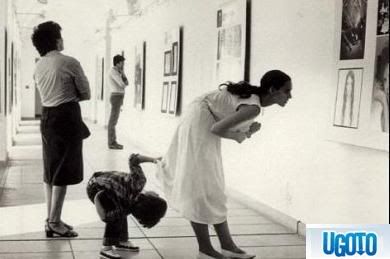
EXHIBITION REVIEW :: Milano (IT)
Julian Schnabel, "Paintings: 1978-2006"
@t Rontanda di Via Besana
"My paintings take up room, they make a stand. People will always react to that. Some people get inspired, others get offended. But, that's good. I like that."
-- J. Schnabel, on Painting
This is no understatement. Julian Schnabel's paintings are massive and take up a lot of room. They are huge, larger-than-life and make us ordinary mortal beings pale in comparison within their presence. His subject matter ranges from portraits of both men and women (friends/colleagues of his over the years) to self-portraits, from his take on Oriental geishas to mixed media collages, recycled art and drip paintings. Born to immigrant parents from the Czech Republic, Schnabel grew up in Brownsville, TX for most of his formative years. At first, he struggled in the art world and worked as a short-order cook until his first solo exhibition in 1975, in New York City. This retrospective of his nearly 30 years of making art led him not only to participate in the Venice Biennale, but also to become a major figure in the Neo-expressionism movement in the mid-1980s.
His portraits are abstract, with elongated figures and much influence alluded to Picasso. His paintings show that he was clearly influenced by Pollock; his "found-objects" collages, by Gaudi. Unconventional religious iconography (a male AND a female Jesus?) are also included in his oeuvre. These works come in all shapes and sizes, which forces one to really ponder on what is going on in all of these works. I personally walked around this exhibit for a good hour, searching every quadrum of my brain to figure out how on earth these canvases were created. It was as if I was seeing Michelangelo's Sistine Chapel for the first time. WOW... did Schnabel use a ladder, or did he simply hang them on the wall and run into them with his paintbrush? Or were they laid flat on the ground and painted on, detail by detail?

It is important to state that sometimes: art is not about how beautiful the final product is, but more about the process it took to get there. You either like it or hate it: the choice is up to you. But, in any case, the closer you look, the more you will come appreciate the technique, skill and the amount of effort it took the artist to create these crazy works of massive quantities and sizes... whether or not you favor the subject matter.
After a thorough analysis of Schnabel’s works as a whole, I decided that my favorite technique was the globs of plaster paint over pieces of broken ceramic plates and saucers, used in his portraits, icons and landscapes, to help achieve tangible texture and taking the influence of Chuck Close to the next level. The wide variety of found and natural objects used by Schnabel, such as nestled together tree branches, as well as the incorporation of classical art materials such as pen & ink, conte' crayon and charcoal -- were more than enough to make my head spin in a state of awe.

The Rontanda di Via Besana is obviously the appropriate venue for such an exhibition. The huge, dome-like, former Renaissance basilica facility is extremely accommodating to the massive size of Schnabel’s works, the cool (and AIR-CONDITIONED) gallery space comfortable for its visitors and lots of natural light coming from the open windows above, along with the dim spotlights shining from above, exudes an essence of spirituality onto each work of art. Indeed a monumental location for a monumental exhibition.



No comments:
Post a Comment